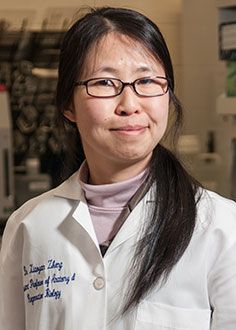
WASHINGTON (March 13, 2013) – While many researchers believe that the Hedgehog (Hh) signaling pathway, which transmits information to embryonic cells for proper development and is important for regeneration, may actually regulate cell-cell adhesion and segregation – there isn’t any evidence. Xiaoyan Zheng, Ph.D., assistant professor of anatomy and regenerative biology at the George Washington University School of Medicine and Health Sciences, is working to change that. With a $747,000 grant from the Eunice Kennedy Shriver National Institute of Child Health & Human Development at the National Institutes of Health, Zheng will focus on identifying the mechanism involved in this process, which may answer long-researched questions about diseases, such as cancer.
“Once we understand the mechanism, we can find better ways to treat the diseases related to these interactions,” said Zheng. “We need to know the ‘why,’ before we figure out the ‘how.’”
The project, titled “Hedgehog-mediated regulation of cell adhesion,” will be funded over a three-year time period.
Increasing evidence indicates that Hh secreted by certain human cancer cells may signal to surrounding tissue and promote tumor growth and metastasis. Malignant invasion might also be considered a normal process of cell segregation in reverse, in which there is cross-adhesion between cancer cells and tissue cells. This study, that focuses on mechanisms by which the Hh signal defines specific cell adhesion, will not only contribute significantly to the scientific community’s knowledge of the molecular and cellular bases of tissue patterning and further understanding of the Hh signal pathway, but will also shed light on the mechanisms of cancer progression, perhaps leading to the discovery of new therapeutic targets in cancers.
“This is a very fundamental question, but a very important question, especially in the process of cancer development,” said Zheng. “For instance, a malignant invasion could be viewed as the reversed process of normal cells segregation, in other words, malignancy mimics a cross adhesion between cancer cells and normal tissue cells. I’m trying to understand the basic, but very important question of how the Hh signal defines cell-cell interaction, which is what I am going to focus on with this grant.”


